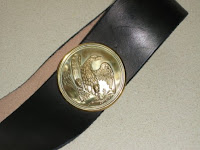
Coming into this hobby, I of course slavered for the leather accoutrements of Duvall Leatherworks whose pieces seem to qualify as works of art. However, the father of two—soon to be three—in me balked a little at the price. A full set of Duvall Federal accoutrements (including brass plates) currently runs $390 plus shipping and handling. All of Mr. Duvall’s pieces which I have seen for sale are truly beautiful and seem to scream, “Buy me big boy.” However, my First Sergeant and friend Mike Cribbs, turned me onto Missouri Boot and Shoe of Neosho, Missouri. And let me say, if I never had a true leather fetish before, I certainly have one now.

There are only two ways to order from MBS: online via Paypal, or an order form by mail using Paypal, cashier’s check, or money order, of which I chose the latter. My order consisted of the following: leather waist belt with standing leather loop and “puppy paw” buckle, a standard Model 1850 cap pouch, an unmarked Pattern 1857 .58 cal cartridge box and strap with eagle breastplate, and a two-rivet bayonet scabbard for an original 1855 bayonet. The cartridge box included two tins, the cap pouch included a cone pick, and all plates were securely attached with leather thongs. The grand total of this complete early-war Federal accoutrement package was $281 plus $10 shipping and handling. According to MBS, orders typically take 4-6 weeks depending on the size of the order and how busy they happen to be at the time. My order, took exactly six weeks and arrived—much to my chagrin—the day after I returned from the 145th Bentonville reenactment.

Heretofore, I had relied upon loaned equipment from our unit’s company stores and an el cheapo belt and buckle combo from a mainstream sutler in Gettysburg. What I received simply blew me away. All of the leather is a supple, waxed flesh with a rich black sheen of the sort you would see on a really good pair of leather boots. Indeed, what I got in no way resembles the shiny black, patent leather looking stuff you will find in the tents of your mainstream sutlers. The leather is high grade and the leather smell which engulfed our family apartment when I opened the box, lingered for several days—subtle, yet manly in the extreme with nary a hint of any sort of petrochemical falseness. My walk-in closet where I store all of my impression remains a leather bound treat whenever I open the door.

As far as construction goes, I have compared my cartridge box and cap pouch with my loaners, which are well-used Jarnagin models. The stitching and construction are as good, if not better, than the Jarnagin models I currently have, and compare quite favorably with the Duvall pieces I have beheld at S&S Sutler in Gettysburg. The leather used by Duvall does appear to be a little bit thicker—especially in the cartridge box flap—with maybe a bit more grain. Duvall’s pieces receive high marks in the living history ranks for fit, finish, and construction. And, had my funding for accoutrements been a bit higher, I would probably have gone with them. However, I in no way feel that my MBS gear is a step back in terms of quality, construction, or dependability.

As far as fit, everything fit perfectly. My waist belt fit my exact measurements—make sure you measure yourself in uniform as recommended. My cartridge box strap allows my box to hang exactly at my hip as it should be—not too high and certainly not too low as you see on some reenactors. I will offer one word of caution. MBS offers their cartridge box straps in both the original 64½ inch length (as per the Army Ordnance Manual) and a 72 inch length for “modern” soldiers. If you are over 5’ 8” tall or have a waist greater than 34 inches, I would strongly suggest you go with the modern length cartridge box strap. My strap is on its longest setting and it fits just right. As for my bayonet scabbard, MBS only asks your blade type, year model, and whether it is a reproduction or an original. I asked for a scabbard made to fit an original bayonet—which I have yet to buy. However, my reproduction bayonet seems to fit just fine even though an original blade is much narrower.

So there you have it. I feel my $291 dollars was money well spent. Although I did not call MBS to inquire about my order or pester them with questions, I did email them twice. The first time to make sure they received my order and the second to specify waxed flesh in my waist belt and cartridge box strap. Both emails were answered promptly and cheerily. Yes I did try all of it on with my uniform as soon as I got it all together. And no I cannot wait to show it all off this weekend at the Sykes Spring Shakedown at Fort McHenry.




























